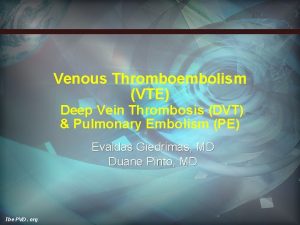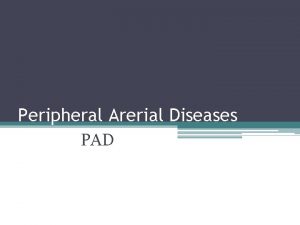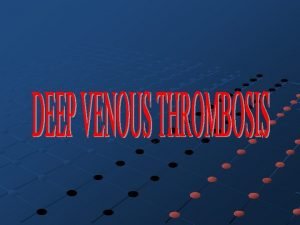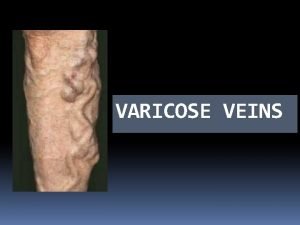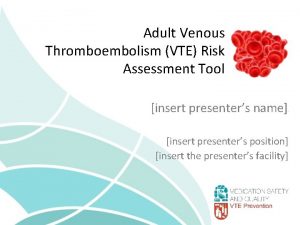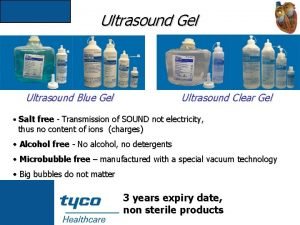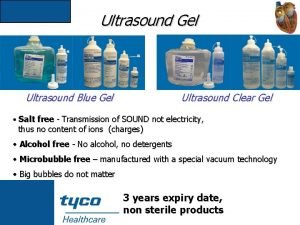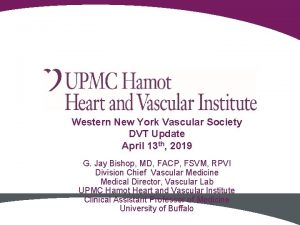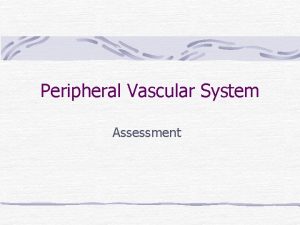DVT Ultrasound Assessment VASCULAR ULTRASOUND STACEY GEHRKE EVIDENCE
















- Slides: 16

DVT Ultrasound Assessment VASCULAR ULTRASOUND STACEY GEHRKE

EVIDENCE # 2 ASAR Competency Statement: “Demonstrate any pathology found and conclude based on clinical and sonographic evidence”

Indications for DVT Assessment Clinical Presentation �Leg Pain �Tenderness �Swelling in one or both legs �Red or discoloured skin (hot to touch in affected area) �Leg fatigue

Risk Factors � Previous DVT � Smoking � Age (over 60) � Obesity � Sedentary lifestyle/immobilization � Long plane flights � Post-operative � Trauma � Thrombophilia � Malignancy (Zweibel & Pellerito, 2000)

What is a DVT? A DVT, otherwise known as Deep Vein Thrombosis, is the formation of a blood clot in a deep vein, which can partially or completely obstruct venous return, causing chronic pain and leg swelling. It can also damage the valves found only in veins. One of the main risks associated with a DVT, particularly in the thigh, is that thrombus can break off, becoming lodged in the lung, known as a pulmonary embolism (PE). Therefore a DVT can be fatal, and medication known as anticoagulants, such as Warfarin, Clexane and Aspirin may be required to treat a patient with a DVT, as well as follow-up examinations post treatment (Davidson & Deppart 1998).

What are the deep veins? �Common Femoral Vein (Thigh) �Superficial Femoral Vein (Thigh) �Popliteal Vein (Knee) �Gastrocnemius Veins (Calf) �Soleal (Calf) �Anterior Tibial (Calf) �Posterior Tibial (Calf) �Peroneal (Calf)

Sonographic Appearance � Visualisation of thrombus in the vein (partial or complete) � Non-compressibility of the vein with direct probe pressure (best assessed in transverse plane) � Non-patency of veins (best assessed in longitudinal plane, with colour doppler and augmentation of the distal foot) � Arteries should not compress Characteristics of Acute and Chronic DVTs Acute Chronic Homogenous, smooth Heterogenous, irregular Hypoechoic Echogenic Soft (deforms with compression) Stiff (non-deformible) Dilated vein Thickened vein wall “Free floating” tail Collateral veins present (Quere 2009)

Patient 1: longitudinal spectral trace of the Common Femoral Vein demonstrating phasic flow. Common Femoral Vein in transverse with split screen demonstrating full compressibility.

Transverse Saphenofemoral Junction with compressibility. Transverse compression of the Femoral Vein.

Transverse compression of the Popliteal Vein. Transverse compression of both the paired Posterior Tibial Veins and the Peroneal Veins in the same image.

Transverse images of the medial Gastrocnemius veins, with the right-hand image of the split screen demonstrating non-compressibility of the veins, as well as echogenic thrombus within the vessels, confirming a DVT.

Patient 2: non-occlusive, chronic segment of echogenic thrombus within the distal Femoral Vein in the adductor canal. Colour doppler with distal augmentation demonstrates that the vein is not completely occluded.

Transverse distal Femoral Vein within the adductor canal showing non-compressibility of the vein. Longitudinal right popliteal vein demonstrates echogenic partially occluding thrombus, extending inferiorly from the Femoral vein to include the popliteal vein.

Transverse Popliteal vein showing echogenic thrombus and non-compressibility, again confirming a DVT, however it is most likely chronic.

Clinical and sonographic evidence should be incorporated into the ultrasound examination of a DVT, including a thorough history, patient symptoms, and collaboration with the ultrasound findings. The 2 patient cases presented, both exhibited the common symptoms associated with a DVT, as well as patient 2 having a history of DVT.

Reference List 1. 2. 3. Davidson, Bruce L, and Eric J Deppart. 1998. “Ultrasound For the Diagnosis of Deep Vein Thrombosis: Where to Now? ” British Medical Journal 316 (7124): 2 -3. http: //search. proquest. com. dbgw. lis. curtin. edu. au/docview/203994 624/fulltext. PDF? accountid=10382 Quere, Isabelle. 2009. “Ultrasound Based Diagnostic Strategies for Deep Vein Thrombosis”. JAMA 301 (9): 933 -935. http: //jamanetwork. com. dbgw. lis. curtin. edu. au/article/aspx? ar ticleid=183485 Zweibel, William J, and John S Pellerito. (2000). “Introduction to Vascular Ultrasonography”. 5 th edn. Elsevier Saunders: Philadelphia, Pennsylvania.
 Non vascular vs vascular plants
Non vascular vs vascular plants Non vascular plant
Non vascular plant Vascular and non vascular difference
Vascular and non vascular difference Ferriman-gallwey scale
Ferriman-gallwey scale Stefanie gehrke
Stefanie gehrke Ramakrishnan database management systems
Ramakrishnan database management systems Peter gehrke
Peter gehrke Ramakrishnan gehrke
Ramakrishnan gehrke Site of dvt
Site of dvt A train travelled 555 km
A train travelled 555 km Risk for venous thromboembolism nanda
Risk for venous thromboembolism nanda Dvt formula
Dvt formula Phlegmasia cerulea dolens definition
Phlegmasia cerulea dolens definition Thrombus fate
Thrombus fate Dvt risk factors
Dvt risk factors Dvt risk factors
Dvt risk factors Dvt risk factors
Dvt risk factors








